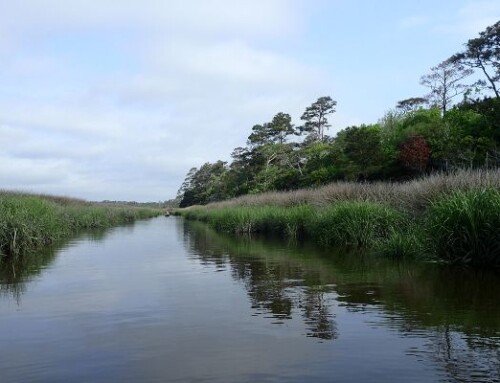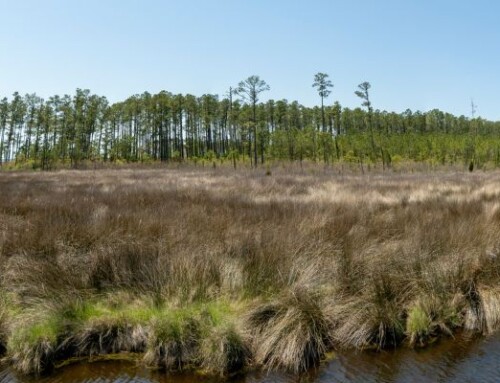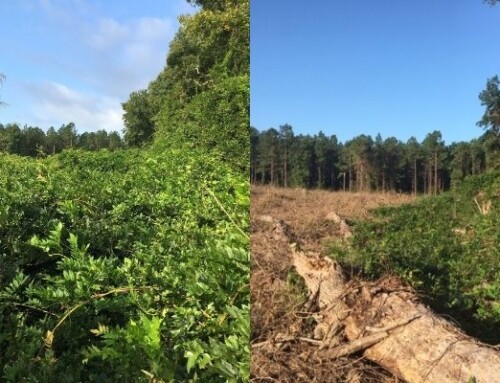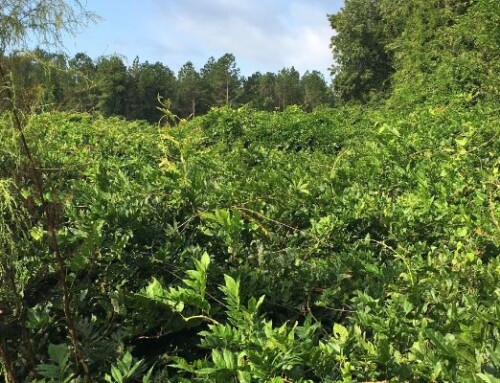Night Stalkers, Dawn Trekkers, Sand Stompers, and Mud Sloggers:
Biologists at Work on Coastal Land Trust Preserves
By Janice Allen
Coastal Land Trust Director of Land Protection
In the dark of night and generally after a rain, wildlife biologist Dave Allen stalks the small ponds at Coastal Land Trust’s Bern Preserve during winter, spring and summer, (January to June), to listen for, and record, frogs calling. Why? Dave’s frog call surveys help the Coastal Land Trust determine whether or not recent pond restoration work, clearing out small trees and shrubs, is improving the habitat for breeding frogs.
Apparently, it is. This year, Dave not only discovered more species of frogs, but also documented southern chorus frogs, a relatively rare species, hollering at the Bern Preserve. Whether or not you like these slimy screamers, frogs play a vital role in healthy ecosystems. They form an integral part of the food chain, prevent disease transmission by feeding on potential carriers like mosquitos, and keep ponds and waterways clean.
Frogs are important.
During the height of the bird breeding season, (early May to late June), Dave wakes at zero dark thirty to drive to sites like the Coastal Land Trust’s Everett Creek and Island Creek Preserves where he carries out breeding bird surveys at dawn. The data he collects from these surveys at Everett Creek have provided the Coastal Land Trust with positive feathered feedback on longleaf pine forest enhancement work there. The data collected at Island Creek will be added to the new North Carolina Bird Atlas, a five-year community science project headed by the N.C. Wildlife Resources Commission to map the distribution and abundance of birds from the Blue Ridge Mountains to the Outer Banks. (Other Coastal Land Trust preserves are slated for inclusion in the Atlas project). Why do we need to know so much about birds? As David Yarnold, past president of the National Audubon Society, said, “The connection between birds and humans is undeniable. We share the same fate . . . birds are the canaries in the coal mine that is the earth’s future.”
Birds are important.
Dave Allen is not the only person trekking through the Coastal Land Trust’s preserves in the dead of night. U.S. Fish and Wildlife Services (USFWS) Biologist Gary Jordan has been setting thin, mesh nets along narrow, thickly forested soil roads to capture bats. Gary’s quest is not only to learn more about bats but to document the presence of the northern long-eared bats, a federally threatened species, in as many coastal counties as possible. Indeed, Gary’s night-netting efforts at the Coastal Land Trust’s Black River Preserve led to the first record of northern long-eared bats in Sampson County. Many folks view bats as scary, sinister creatures, and may not see value in this work. But bats, these fanged and flighted fur balls, play an essential role in pest control, plant pollination, and seed dispersal.
Bats are important.
Other biologists like Dale Suiter of USFWS, and Susan Gale and Greg Rubino of N.C. Division of Water Resources, are gearing up to conduct research this summer on the Coastal Land Trust preserves. Dale plans to stomp through the deep sand at the Coastal Land Trust’s Hutaff Island, gathering data on seabeach amaranth, a sand-binding plant. Susan and Greg will slog the wetlands at the Coastal Land Trust’s Sea Gate and Nevil’s Creek Preserves, taking soil and vegetation samples to study and document the effects of sea level rise. The Coastal Land Trust thanks all these hard-working biologists, the night stalkers, dawn trekkers, sand stompers, and mud sloggers that use the Coastal Land Trust’s preserves to collect important information on plant and wildlife species, and the health of our environment. The Coastal Land Trust’s preserves, oases of North Carolina’s coastal biodiversity, and the studies conducted on them, are important.
Photos Credit: Northern long-eared bat by Gary Jordan, both of U.S. Fish and Wildlife Service






